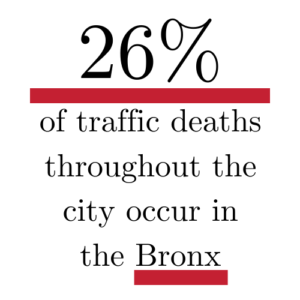Yes, Roadway fatalities are on the rise in the Bronx. The borough is the only one in New York City that has seen an increase in collision deaths since this time last year. Safety officials have recently acknowledged that improvements to safety measures in this area are long overdue, despite the changes that have been made elsewhere throughout the city.
Residents of the Bronx are no strangers to disparity. The communities in this part of New York City experience disproportionately poor health, both specifically related to COVID-19 and overall health. Life expectancy in this borough is also low compared to the rest of the city. The poverty rate for New York state is approximately 13%, but in the Bronx, that number jumps to 26%. Is it this economic inequality that influences the unequal distribution of resources from the city, or vice versa? Learn more about the increasing risks of roadway concerns in the bronx from our experienced Bronx car crash lawyers.
The Bronx and Road Safety
 This pattern of disproportionate harmful impact extends to the safety of the roads that traverse the borough. The Institute for Traffic Safety Management and Research (ITSMR) reports that, in 2020, 50 people were killed in traffic accidents in the Bronx. That number equates to just over 22% of the total number of crash fatalities throughout the city that year. Preliminary ITSMR reports for 2022 show an increase in percentage, with nearly 26% of traffic deaths throughout the city occurring in the Bronx.
This pattern of disproportionate harmful impact extends to the safety of the roads that traverse the borough. The Institute for Traffic Safety Management and Research (ITSMR) reports that, in 2020, 50 people were killed in traffic accidents in the Bronx. That number equates to just over 22% of the total number of crash fatalities throughout the city that year. Preliminary ITSMR reports for 2022 show an increase in percentage, with nearly 26% of traffic deaths throughout the city occurring in the Bronx.
High-traffic roads in heavily populated areas often see an increased number of crashes, which is why there has been pressure from grassroots organizations and community members to force government officials to take action. NYC has been partnering with Vision Zero since 2014 to improve the safety of streets for motorists, pedestrians, and cyclists.
Vision Zero implements road design, education, enforcement, and legislative action to decrease crashes and injuries. However, despite the good intentions of this program, not every New York borough is seeing improvements. Neighborhoods like the Bronx that have been historically forgotten or underserved are not reaping the benefits of road safety improvements touted to be serving the most vulnerable.
Roads in the Bronx, including Broadway, Bruckner Boulevard, and the Grand Concourse, consistently place on lists of the most dangerous in New York. There are very few bike lanes of any kind throughout the borough and even fewer dedicated or protected lanes. These conditions are a result of inadequate city planning at best and deliberate neglect at worst.
Broad Impact of Traffic Accidents
The financial cost of traffic fatalities for the state of New York in 2018 totaled over $1.4 billion. Cyclists accounted for $39 million of that total, and pedestrians equaled approximately $318 million. The economic impact of deadly crashes is especially harmful to lower income households. Losing a loved one takes a tremendous toll on every aspect of a person’s life, and if the deceased was also responsible for contributing to household expenses, the financial impact could be devastating.
The high number of families and individuals living below the poverty line in the Bronx means that many households do not have the monetary resources to withstand such a tragedy. Loss of income, medical expenses, funeral costs, and property damage all combine to create a cataclysm in the financial lives of borough residents. Add to that the emotional and physical harm caused by hazardous road conditions, and Bronxites experience traffic collisions to a degree that other boroughs residents do not. If you or a loved one has suffered injuries after a bronx auto accident schedule a free consultation with our experienced legal team to learn your financial recovery options.
Potential for Safety Improvements
The U.S. Department of Transportation suggests catering safety initiatives to localized needs, basing improvements on the specific issues that create dangerous conditions for communities. Such plans would be informed by data on high-crash locations, red-light running, speeding occurrences, and vulnerable population demographics. With this data, an effective and tailored approach to improving road conditions in each borough could be created, and yet residents of the Bronx are still not being made a priority.
Even in the absence of quantifiable data to create location-specific solutions, there are generalized solutions that tend to be universally helpful for improving road safety. The U.S. Department of Transportation’s Complete Streets initiative focuses on designing streets that are safe and accessible for all users by designing and operating roads efficiently and safely. Some of the suggestions for implementing these strategies are:
- Promoting walking and biking
- Increasing infrastructure for bicycles and pedestrians
- Expanding public transit options
- Adding speed humps or raised intersections
- Narrowing roadways
NYC’s Vision Zero initiative features numerous improvements made throughout the city on its website. They mention constructing pedestrian refuges in Queens, instituting turn bans in Brooklyn, converting a block of the roadway into a shared street near Madison Square Park, and redesigning a segment of road to accommodate cyclists in Manhattan.
None of these featured safety improvements took place in the Bronx, nor do they directly affect the residents living in the Bronx. This isn’t to say that the Vision Zero program hasn’t done anything to improve road conditions and safety on the streets throughout each borough. They’ve painted streets for increased visibility, added countdown signals at wide crosswalks, and implemented left turn signals in the Bronx. However, many community members do not feel the changes that have taken place are adequately addressing the severity of the issues.
Bronx Road Dangers and Demographics
In 2018, only 40% of Bronxites owned cars, yet a disproportionately high number of crashes occur in the borough. In fact, an inverse relationship between the people who drive cars and the people who get hit by cars can often be found in large metropolitan areas. This means that cyclists and pedestrians face a higher chance of falling victim to the dangers of unsafe roads that were not designed to accommodate them, making this demographic especially susceptible to the effects of the inequitable distribution of safety solutions.
The New York City Pedestrian Safety Study and Action Plan states that locations with higher populations of Black and Hispanic residents have increased crash rates. Communities in the Bronx are 43% Black and 56% Hispanic or Latino, compared to New York City as a whole at 23% and 28%, respectively.
Planned Improvements Versus Potential for Improvements

Bronx Accident Lawyer, Andrew Finkelstein
Officials familiar with the safety and infrastructure disparity in the Bronx have announced that further plans are in the works for the borough. Anticipated projects include designating space for additional bike lanes and completing various bus improvement projects. The adequacy of these plans comes into question, however, after considering the substantial dangers present for pedestrians, bicyclists, and commuters in the borough. What potential changes could be made that may impact this community in a more significant way?
Awareness and increased funding are vital for the Bronx to receive the much-needed road enhancements it needs. This part of New York City has long been overlooked in terms of infrastructure, economic investment, and development opportunities, but changes can and should be made to improve the quality of life for locals and residents.
Many traffic safety issues can be relatively simple to address, and, aside from the oft-utilized options mentioned previously, the potential for creative solutions is endless.
- Create “School Streets” by making the roadways around schools vehicle-free.
- Block off sections of streets one day per week to encourage safe outdoor neighborhood activities.
- Decrease parking availability to promote walking or using public transportation, which would also create the space to add bike lanes.
- Increase the number of available bike racks and other secure bike storing solutions.
- Add more pedestrian features like covered seating areas, bathrooms, and other facilities.
Perhaps most importantly, city officials and NYC residents should acknowledge and address the disparity that prevents equal access to safe commutes. Listen to the people most affected by these issues. Partner with organizations and groups that have a legitimate interest in improving the conditions and the lives of the people in these communities. In a city with a reputation built on dreams and opportunity, there shouldn’t be limits on innovative ways to promote safety, inclusivity, and equity for all of its residents.
